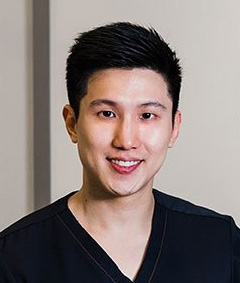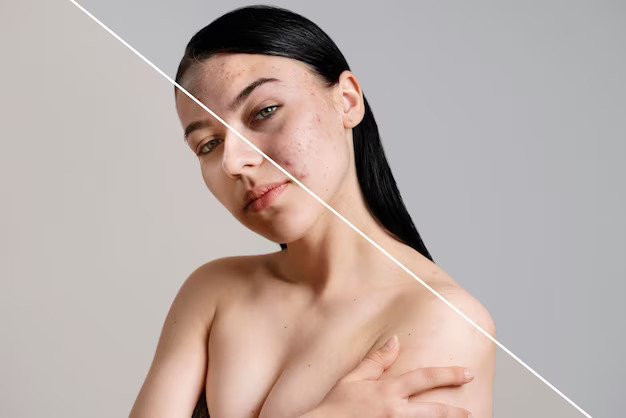Neck acne, often overlooked yet equally distressing as facial acne, is a common skin lesion that affects many individuals worldwide. Although it may not be as visible as facial acne, neck acne can still cause self-consciousness and insecurities in those who suffer from it.
This blog post delves into the causes and potential treatments of neck acne and how it can be effectively prevented. Understanding the fundamentals can help you navigate your way towards maintaining healthy and clear skin. Join us as we unravel the mysteries behind this often-neglected dermatological concern.
Contents
What is neck acne?
Neck acne is a skin condition characterised by pimples, blackheads, and whiteheads on the neck. It shares similarities with facial acne, as the clogging of pores causes both due to excess sebum and dead skin. However, neck acne can be more challenging to treat because the skin on the neck is thicker, and the pores are larger, making them more prone to clogging. Additionally, external factors like clothing friction, sweat, and hair products can contribute to the development and persistence of neck acne.
Who is most likely to get acne on the neck?
Like other forms of acne, neck acne can be influenced by various factors. Hormonal fluctuations during adolescence can lead to increased oil production, making teenagers prone to this condition. However, it can also affect adults, especially women, due to hormonal changes during menstrual cycles, pregnancy, or menopause.
Gender is another factor, with males slightly more susceptible in their teens due to higher testosterone levels, which can trigger excess sebum production. Women tend to experience acne outbreaks more frequently as adults due to hormonal fluctuations.
Certain hormonal imbalances, such as Polycystic Ovary Syndrome (PCOS), can also increase the likelihood of developing neck acne. This condition results in an overproduction of androgens, male hormones that contribute to acne development. Understanding these risk factors aids in early detection and effective management of neck acne.
Common Culprits to Look Out For

Neck acne can surface due to a variety of triggers. Here are some common culprits to be mindful of:
Poor Hygiene: Neglecting to properly cleanse the neck area can lead to dirt, sweat, and oily skin. Over time, these can clog pores and lead to acne.
Friction from Clothing and Accessories: Tight collars, scarves, or necklaces can irritate and trap sweat and dirt against the skin, contributing to acne development. This is often termed as ‘acne mechanica’.
Hair Care Products: Some ingredients in hair products, like silicones or oils, can seep onto your neck and clog your pores when your hair rests on your neck or during shower rinse-offs.
Diet: Certain foods, particularly those high in sugar and dairy, have been linked to acne breakouts. A high glycemic diet can stimulate an insulin spike in the body, increasing sebum production.
Stress: High-stress levels can trigger hormonal fluctuations, which can, in turn, lead to increased sebum production and acne breakouts.
Hormonal Fluctuations: As mentioned earlier, factors like menstrual cycles, pregnancy, and menopause, or conditions like PCOS, can trigger hormonal changes, leading to overproduction of sebum and subsequent acne.
Types of Neck Acne
There are several types of neck acne, each differing in appearance and severity, and understanding these types can aid in the effective treatment and management of the condition.
Blackheads (Open Comedones): Small black or yellow bumps develop on the skin. They are formed when a hair follicle becomes clogged with sebum. The black appearance is not due to dirt but to the oxidation of melanin, the skin’s pigment, when exposed to air. Regular exfoliation and maintaining good hygiene can help in managing blackheads.
Whiteheads (Closed Comedones): Similar to blackheads, whiteheads are formed when pores get blocked with sebum and dead skin cells, but they are fully enclosed by the skin’s surface, giving them a white or yellowish appearance. Over-the-counter treatments containing salicylic acid can be effective in treating whiteheads.
Papules: These are small, red, tender bumps with no head. They occur when the walls surrounding your pores break down due to severe inflammation. It’s important not to pick or squeeze them as it can lead to scarring. Topical retinoids or antibiotics can be used to treat blemishes.
Pustules: These are similar to papules but have a white tip in the centre caused by a buildup of pus. They form when the walls around your pores break down, leading to inflammation and pus. Pustules should never be popped as it can lead to scarring. Applying benzoyl peroxide or a topical antibiotic can help in treating pustules.
Nodules: These are large, hard, painful lumps beneath the skin’s surface. They form when clogged pores endure further irritation and grow larger. Unlike other forms of acne, nodules can persist for weeks or months. Their treatment often requires prescription medication.
Cystic Acne: This is known to be the most severe form of acne and occurs when bacteria trapped in hair follicles cause the area to become red and swollen. Cystic acne can be painful and can possibly cause scarring. It is recommended to consult a dermatologist for its treatment as it usually requires a combination of topical treatments and oral medications.
In each case, it’s important to maintain a regular cleansing routine and avoid irritating the area with harsh skincare products. Remember, once acne develops, it’s often a matter of managing it until it naturally resolves. If over-the-counter treatments don’t work, or if the acne is severe or causing distress, it’s important to seek advice from a healthcare professional or a dermatologist.
What Causes Neck Acne?
Neck acne is caused by a combination of factors, including the following factors:
Hormonal Imbalances
Hormonal imbalances play a significant role in neck acne development. Androgens like testosterone can stimulate sebaceous glands, leading to excess sebum production. When sebum is overproduced, pores can become clogged, creating a favourable environment for acne-causing bacteria. This results in inflammation and acne formation. Hormone levels fluctuate during puberty, menstrual cycles, pregnancy, and menopause, and conditions like Polycystic Ovary Syndrome (PCOS) exacerbate sebum production.
Pore-Clogging Ingredients in Product
Certain ingredients in skincare and haircare products can clog pores and contribute to acne formation. These are often referred to as comedogenic ingredients. It’s important to be mindful of such ingredients, especially if you’re prone to neck acne. Some common comedogenic ingredients include:
Lanolin
Isopropyl Myristate and Isopropyl Palmitate
Coconut Oil
Silicones (e.g., Dimethicone, Methicone)
Choose Non-Comedogenic Products
When choosing skincare and haircare products, especially if you’re prone to acne, opting for non-comedogenic items is crucial. Non-comedogenic means the product is specially formulated to not block pores, reducing the likelihood of acne development.
Here are a few tips when choosing non-comedogenic products:
Read Labels Carefully: Always check the product label for the term ‘non-comedogenic’. If this is indicated, the product is less likely to clog your pores and cause acne.
Opt for Oil-Free Products: Oil-free products are less likely to clog your pores.
Avoid Heavy Creams: Light lotions and serums are generally less likely to block pores than thicker, heavier creams.
Research Ingredients: Get familiar with common comedogenic ingredients and avoid products that contain them.
Friction and Irritation
Friction and irritation are significant factors that can exacerbate skin conditions and contribute to the formation of neck acne. This is often referred to as ‘acne mechanica’.
Clothing and Accessories
Tight clothing and accessories that rub against the skin regularly can irritate, leading to acne breakout. Materials that don’t allow the skin to breathe can trap sweat and oil against the skin, clogging pores and creating a perfect breeding ground for acne-causing bacteria. Accessories like necklaces, scarves, or collars that constantly graze the skin can cause similar issues.
Personal Habits
Personal habits such as constantly touching, scratching, or scrubbing the neck area can also stimulate acne formation. Frequent touching can transfer dirt, oil, and bacteria from your hands to your neck, clogging pores and causing inflammation. Over-scrubbing or using harsh cleansers can strip the skin of its natural oils, causing it to overproduce oil to compensate, clogging pores and creating a favourable environment for acne.
Diet and Lifestyle
Diet and lifestyle significantly impact our skin’s condition, and certain habits can contribute to the development of neck acne.
Dietary Influence: Some foods, especially those with a high glycemic index, like white bread and sugary snacks, may trigger acne by raising blood sugar levels and insulin production. Dairy products might also contribute to acne in some.
Stress: Stress can disrupt hormone balance, leading to increased sebum production and inflammation, potentially worsening acne.
Lack of Exercise: Regular exercise reduces inflammation, boosts the immune system, and lowers stress levels, all of which can help prevent acne. Showering after workouts is essential to remove sweat and oil that can clog pores.
How to Get Rid of Pimple on Neck?

Maintaining good neck hygiene and regular exfoliation is crucial to prevent neck acne. Like the face, the neck can accumulate dead skin, sweat, and excess sebum, leading to clogged pores and acne. Regular cleansing with a gentle, non-comedogenic cleanser can remove these impurities without stripping the skin’s natural oils.
Exfoliation is also important to slough away dead skin cells that can mix with sebum and clog pores. Gently exfoliate the neck area once or twice weekly using a mild scrub or a brush with soft bristles.
Other ways to get rid of neck acne include the following:
Over-the-Counter Products
Several over-the-counter products can effectively treat acne. Ingredients like salicylic acid and benzoyl peroxide are commonly found in these products. Salicylic acid exfoliates the skin and unclogs pores, while benzoyl peroxide kills acne-causing bacteria and helps remove excess oil.
Prescription Medications
If over-the-counter acne treatments aren’t effective, a healthcare professional might prescribe stronger medications. These might include topical retinoids, which work by unclogging pores and preventing acne formation, or antibiotics that kill bacteria and reduce inflammation.
Medical Procedures
Medical procedures may be recommended for severe or persistent acne. These options include:
Chemical Peels: These remove the top skin layer, encouraging new skin growth.
Light Therapies: Blue and red light therapies kill bacteria without harming the skin.
Drainage and Extraction: Dermatologists may perform these procedures to remove large cysts that don’t respond to medication.
Laser Therapy: Various laser treatments can target deeper skin layers, reducing sebum production and bacteria without surface damage.
Photodynamic Therapy (PDT): This involves applying a light-sensitising solution and exposing the skin to specific light wavelengths, destroying bacteria and reducing oil production.
Microdermabrasion: This procedure exfoliates the skin, unclogs pores, and promotes new skin cell growth, effectively managing acne.
Consulting a dermatologist will help determine the most suitable acne treatment based on individual needs.
Home Remedies and Natural Treatments
 Several home remedies have shown promise in the treatment of acne. It’s important to note that these home treatments should not replace ways to treat neck acne professionally but may serve as supplementary measures.
Several home remedies have shown promise in the treatment of acne. It’s important to note that these home treatments should not replace ways to treat neck acne professionally but may serve as supplementary measures.
Tea Tree Oil: Tea tree oil is known to be a popular natural remedy for acne due to its anti-inflammatory and antimicrobial properties. Dilute a few drops of tea tree oil with witch hazel (20 to 40 drops) and apply to the skin once or twice a day using a cotton swab.
Honey: Raw honey, known for its antibacterial and anti-inflammatory properties, can soothe inflamed acne and inhibit bacterial growth. Apply a thin layer of raw, organic honey to the skin, leave it on for 10-15 minutes, and rinse off gently with warm water.
Green Tea: Green tea, with its antioxidant and anti-inflammatory properties, may help manage acne. Apply a cooled green tea bag to the affected area or drink green tea daily to reduce inflammation and bacteria.
How to Prevent Neck Acne?
If you’re prone to neck acne, there are steps you can take to prevent it from occurring:
Proper Cleansing Techniques:
Use non-comedogenic (won’t clog pores) products for your neck.
Avoid using harsh soaps or scrubs, as they can irritate the skin.
Gently cleanse your neck with a mild, fragrance-free cleanser.
Clothing Choices:
Avoid wearing tight-fitting clothing, especially around the neck, as it can trap sweat and oils.
Opt for breathable fabrics, like cotton, to minimise friction and skin irritation.
Hygiene Practices:
Wash your pillowcases and bedsheets regularly to prevent the buildup of sweat and oils.
Avoid touching or rubbing your neck frequently, as it can introduce dirt and bacteria to the skin.
Balanced Diet:
Maintain a diet rich in fruits, vegetables, whole grains, and lean proteins.
Limit the consumption of high-glycemic foods and dairy products, as they may exacerbate acne in some individuals.
Stress Management:
Proper sleep and regular physical activity can also help manage stress levels.
Effective Skincare Routine for Neck Acne
Implementing an effective skincare routine can significantly manage dry skin and prevent neck acne. The following steps should be part of your daily skincare regimen:
Cleansing: Begin by gently cleansing your neck with a mild, non-comedogenic cleanser, such as Cetaphil Gentle Skin Cleanser, to remove impurities without irritating your skin.
Exfoliation: Exfoliate your skin once or twice weekly to remove dead skin cells and prevent pore clogging. Neutrogena Deep Clean Gentle Scrub is a gentle exfoliator suitable for this purpose.
Toning: After cleansing, apply a soothing toner to restore your skin’s pH balance and tighten pores.
Treatment: For individuals dealing with acne, a product specifically designed for acne treatment containing salicylic acid or benzoyl peroxide can be beneficial. Clean & Clear Advantage Acne Spot Treatment is a trusted choice.
Moisturising: Finish your skincare routine with a non-comedogenic moisturiser that hydrates your skin without clogging pores. Consider using a light moisturiser such as the Neutrogena Hydro Boost Gel-Cream.
Sun Protection: During the day, use a broad-spectrum sunscreen to protect your skin from harmful UV rays. La Roche-Posay Anthelios XL Ultra Light Fluid SPF 50+ is a lightweight, non-comedogenic sunscreen suitable for acne-prone skin.
When to seek a dermatologist?

It’s important to consult a dermatologist if neck acne persists despite your best efforts in at-home care and over-the-counter treatments. Key indicators that it’s time to seek professional help for chronic acne include:
Persistent Acne: If your acne doesn’t improve after 2-3 months of home treatment, it might be time to consult a dermatologist.
Severe Acne: If you have deep, painful acne, such as cysts or nodules, you should seek professional help. These kinds of severe acne will likely leave scars if not treated by a professional.
Acne Scars: If you notice signs of scarring, a dermatologist can help with treatments that reduce the appearance of scars.
Emotional Distress: Acne can significantly impact your quality of life and emotional health. If you’re feeling overly self-conscious or depressed because of your acne, seek help from a dermatologist.
A dermatologist can provide a more tailored treatment plan for your specific needs and monitor your progress, making the necessary adjustments to your treatment plan along the way.
Conclusion
Managing and treating neck acne is an achievable goal with the right skincare routine, lifestyle adjustments, and medical advice. While the journey towards clear skin may be challenging and filled with trials, the key lies in consistency and patience. The effectiveness of treatments varies between individuals; hence, understanding your unique skin type and needs is crucial.
A tailored skincare regimen, balanced diet, proper hygiene practices, and stress management can significantly improve your skin’s overall health. Remember, persistent cases of acne warrant a visit to a dermatologist who can provide a more personalised treatment plan.
Don’t be disheartened by temporary setbacks; persist with your skincare routine, maintain a healthy lifestyle, and you’ll reap the rewards of your diligence in due course.





